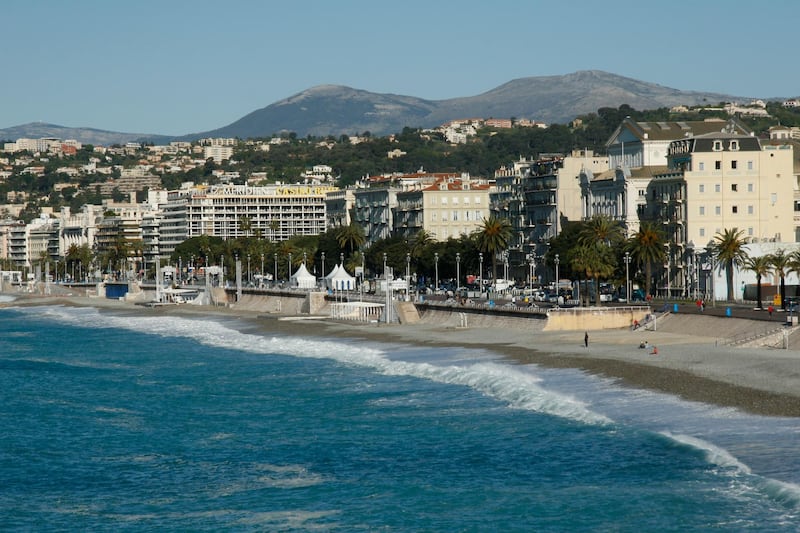The drive down from the hills above Nice always takes my breath away; turquoise waves crashing down on the curved beach of the Baie des Anges, grand palaces, hotels and casinos lining the waterfront Promenade des Anglais like ornate decorations atop a wedding cake. The scene is unchanged since the glory days when this was the most glamorous destination on the Cote d'Azur – the preferred resort of British royalty, Russian tsars and American millionaires.
But times are changing for the Grande Dame of the Riviera, as the city is waking up from a long slumber and putting the 2016 Bastille Day terrorist attack behind it, reinventing itself as a destination for cutting-edge contemporary art, theatre and music, and a developing restaurant scene that is exciting fans of vegetarian, vegan and locavore cuisine.
The city's historic centre, Le Vieux-Nice, is bewitchingly beautiful with its pastel baroque architecture and romantic narrow lanes. Sadly, the tiny bistros that have proudly served traditional "Cuisine Nissarde" for generations, like Chez Acciardo and Escalinada, are being outnumbered by fast-food establishments, while the ever-colourful Marche aux Fleurs is now more a market for souvenirs than a path to local Nicois (inhabitants of Nice).
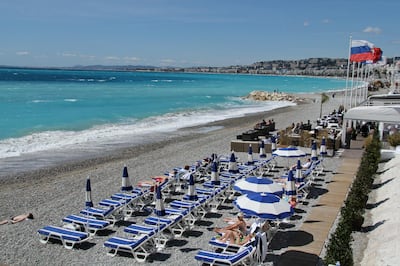
To discover the new Nice, I jump on the super-efficient tram and head over to the neo-bohemian Liberation neighbourhood that is dominated by the grandiose neoclassical facade of the former Gare du Sud train station.
In the square in front of the old station, the sprawling Marche de la Liberation is a foodie paradise, where bio cheeses and vegetables, olive oil and fragrant Provencal herbs are sold by the producers themselves, while the wonderfully fresh fish has come straight off local boats.
At the weekends, the sunny pavement terraces of Brasserie Gambetta and Café Altra Casa look out over the market stalls and are packed for brunch and lunch. This is the perfect place to indulge in a classic seafood platter piled high with oysters, sea urchins, crabs and mussels.
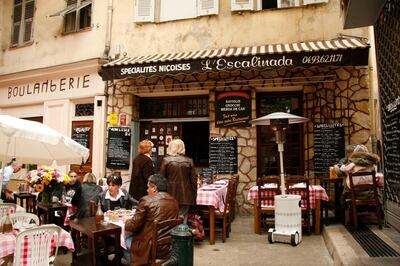
A well-known early-morning visitor to the fishmonger stalls is bubbly Japanese chef Etsuko Bodhizen. I have booked in for her lunchtime table d'hote, where Etsuko prepares an exquisite seafood and vegetarian meal in her zen home for the very reasonable price of €20 (Dh85) a head. Her cuisine is essentially Japanese, but uses only local Nicois organic produce, and the meal she prepares is nothing less than a feast with line-fished red mullet roasted in her homemade sesame sauce, traditional non-pasteurised miso soup with local oyster mushrooms, wakame and kelp, and a surprising but delicious dessert of raw carrot cake.
She is not the only chef inspired by the high quality local food at the Liberation market. In a quiet side street off the Promenade des Anglais, the modern bistro, Le Canon, serves 100 per cent seasonal locavore cuisine. Effusive owner, Sebastian Perinetti, explains the daily dishes with descriptions of where each farm is in the surrounding countryside, who the farmer is, even the names of some of the animals whose milk makes the cheeses, while his Moroccan chef, Elmahdi Mobarik, creates sophisticated dishes like a smooth artichoke veloute and homemade raviolis stuffed with creamy sheep’s cheese, €9 (Dh38).
______________________
If you go:
Where to stay
Le Negresco Hotel (www.hotel-negresco-nice.fr) costs from €325 (Dh1,400) per night, and is a chic, elegant, wonderfully over-the-top option. For a hip culture hotel, try Hotel Windsor (www.hotelwindsornice.com), which starts from €140 (Dh600) a night. The Jay (www.hotel-jay.com) is a fashionable boutique property costing from €100 (Dh430) a night.
The flights
Emirates Airlines (www.emirates.com) flies directly to Nice from Dubai (6.5 hours) from around Dh3,000 return, while Etihad Airways (www.etihad.com) flies there with a stopover (11.5 hours total flight time) from approximately Dh2,700 return.
______________________
Seafood lovers should make a beeline for Peixes, opposite Nice’s National Opera House, where the cuisine blends local fish with tangy, exotic fruits and spices, such as a sea bream carpaccio (€13, Dh55), marinated in coconut milk, lemon grass and tamarind or tuna tatami with wasabi mayonnaise, wakame and kimchi “maison”.
Another neighbourhood in the throes of change is around the bustling maritime Port Lympia. Etsuko recommends that I check out the vegan establishment where she sometimes guest-cooks, called Badaboom. Run by extrovert Ghanese-American Barbara Basalgete, Badaboom styles itself as a bistrot vegetal, but proposes poetry readings, yoga classes, art exhibitions and music, as well as some very tasty food prepared in an open kitchen by Nico, her Nicois husband.
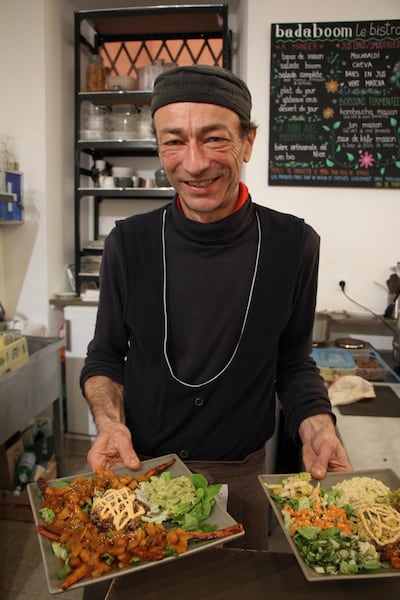
His speciality salad, at €13.50 (Dh58), is a giant bowl filled with everything from endive, celery and hummus, to sweet potato, fennel, carrots and ginger, while a faithful local clientele come just for the ultra-healthy detox smoothies, priced at €7 (Dh30); made with coconut water, avocado, spinach, dates and cashews, or almond milk, chocolate, matcha tea and spices.
The hip streets surrounding the port really come alive after sunset. I kick off at a favourite local haunt, the cool shabby-chic Comptoir Central Electrique, which feels like a cosy club with its battered sofas, and whose pavement terrace is perfect for people-watching – from local seamen to high-heeled fashionistas tripping back to their private yachts moored in the port. Chez Pipo is a great place to try Nice’s famous “socca” – a wafer-thin crispy chickpea flatbread they have been baking since 1923 – and the place to end the evening is Le Ketje, a lively locale where bands perform each weekend, from rock ’n’ roll to country and French chansons.
______________________
Read more:
Explore 11 of Europe's best summer activity breaks
My Kind of Place: Arles, France
Discovering a rural retreat in Sarlat-la-Canéda, France
______________________
Nice has long been the Riviera's cultural capital, with world-class art museums that are on every visitor's must-see list. Up in the exclusive hills and luxurious mansions of the Cimiez quarter, the Musee Matisse has the largest collection of paintings by the modern master who made Nice his adopted home, while a mile down the road, the Musee Chagall honours another of the 20th century's greatest artists who lived and painted here, inspired by the colours of the Cote d'Azur. While more contemporary artists with close links to Nice – Cesar, Arman, Yves Klein, Nikki de Saint-Phalle – are showcased in the town centre's immense Museum of Contemporary Art (www.mamac-nice.org), outside the established museum circuit there exists a vibrant avant-garde scene, which many tourists never discover. A dozen offbeat venues are dotted around the city presenting cutting-edge artists.
Nice may be known for its exclusive cosmetic surgery clinics, but it still comes as a surprise to learn that these alternative art venues go under the provocative group name of Botoxs. I begin a tour at Le 109, an immense industrial abattoir, saved from demolition by a last-minute intervention by French architect Jean Nouvel (the man behind the design of Louvre Abu Dhabi), transformed today into artist residences, exhibition spaces and a dance floor for all-night techno, hip-hop and electronic parties.
In the midst of chic residential housing, La Maison Abandonnee is an empty villa that has become a magical space for installations, while back near the Liberation neighbourhood, I stumble upon Espace a Vendre, a gallery showcasing emerging local artists with a cavernous exhibition space at the back in a former electric generator station.
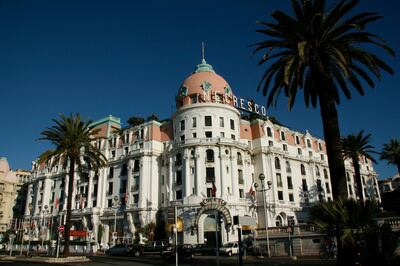
No visit to Nice is complete without experiencing Le Negresco, more national monument than mere hotel, whose distinctive red-domed facade dominates the Promenade des Anglais. While the luxury rooms offer the perfect panorama across the Baie des Anges and their Michelin two-star Chantecler restaurant is Nice's gourmet reference, the hotel's real heart and soul is the grand Negresco Bar, decorated with priceless 17th-century tapestries.
I recall seeing the eccentric owner, Madame Augier, 95, taking afternoon tea with her cat. Like the rest of the city, Le Negresco is moving with the times – mixologists create inventive drinks, while the bar quickly fills up. It is the new fashionable rendezvous for Le Tout Nice, and instead of gentle chamber music, an in-house DJ plays funky jazz as the sun sets over the Mediterranean.
